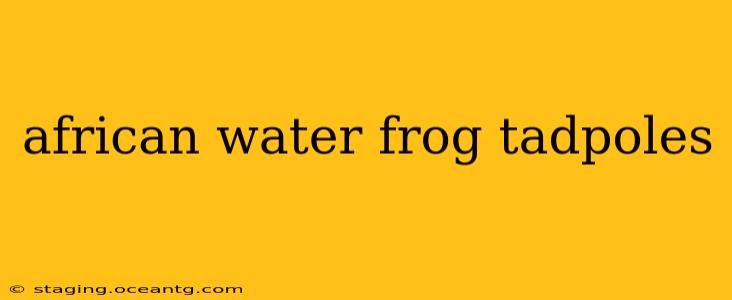The African water frog ( Ptychadena spp. ) encompasses a diverse group of frogs, and their tadpoles exhibit a fascinating array of characteristics. While specific details can vary depending on the exact species, this guide provides a comprehensive overview of their development, behavior, and ecology. Understanding these amphibious creatures offers valuable insights into the intricacies of their ecosystem and the challenges they face.
What do African water frog tadpoles look like?
African water frog tadpoles, like those of many other frog species, undergo a significant metamorphosis. Early-stage tadpoles are typically small, oval-shaped, and possess a prominent tail. Their coloration can vary depending on the species and their environment, ranging from dark brown or black to olive green or even yellowish hues. As they grow, they develop more pronounced features, including well-defined eyes and gills (external in early stages). Larger tadpoles exhibit a more streamlined body shape, better suited for efficient swimming. Their bodies become more muscular as they prepare for the metamorphic transformation to froglets.
What do African water frog tadpoles eat?
African water frog tadpoles are primarily herbivores, although some species may exhibit omnivorous tendencies. Their diet mainly consists of algae, decaying plant matter, and other organic debris found in their aquatic environment. They use specialized mouthparts to scrape algae from surfaces and filter smaller particles from the water. As they mature, some tadpoles might incorporate small invertebrates into their diet, transitioning towards the carnivorous habits of adult frogs.
How long does it take for African water frog tadpoles to metamorphose?
The time it takes for African water frog tadpoles to complete metamorphosis varies considerably depending on several factors, including species, water temperature, food availability, and environmental conditions. Generally, the process can take anywhere from a few weeks to several months. Warmer temperatures and abundant food sources usually lead to faster development. The metamorphic process involves a remarkable transformation, where the tadpole's tail is reabsorbed, limbs develop, and lungs replace gills as the primary respiratory organs.
Where do African water frog tadpoles live?
African water frog tadpoles inhabit a wide range of aquatic environments across sub-Saharan Africa. Their preferred habitats typically include temporary or permanent pools, ponds, marshes, and slow-moving streams. The specific habitats occupied depend heavily on the species and the availability of suitable breeding sites. These environments offer essential resources such as food, shelter, and protection from predators. The availability of suitable breeding sites is crucial for the survival and reproductive success of the species.
What are the predators of African water frog tadpoles?
African water frog tadpoles face a variety of predators throughout their development. These include aquatic insects, fish, larger amphibians (including other frog species), reptiles (like snakes and crocodiles), and birds. Predation pressure can significantly affect tadpole populations, influencing their survival rates and overall distribution. Effective camouflage and rapid growth strategies are crucial for tadpoles to evade predators and increase their chances of successful metamorphosis.
How can I identify different species of African water frog tadpoles?
Identifying different species of African water frog tadpoles can be challenging and often requires expertise in amphibian taxonomy. Key features to look for include size, shape, coloration, tail length and morphology, and mouthpart structure. Detailed morphological studies and possibly genetic analysis are often necessary for accurate species identification. Specialized field guides and consultation with herpetologists can provide valuable assistance in this process. It is essential to approach identification with caution and consult reliable sources, as misidentification can have implications for conservation efforts and scientific research.
Note: This information is intended for educational purposes. Observing African water frog tadpoles in their natural environment should be done responsibly, minimizing disturbance to their habitat and avoiding any interference with their life cycle. Always prioritize the conservation and protection of these fascinating creatures and their ecosystems.
